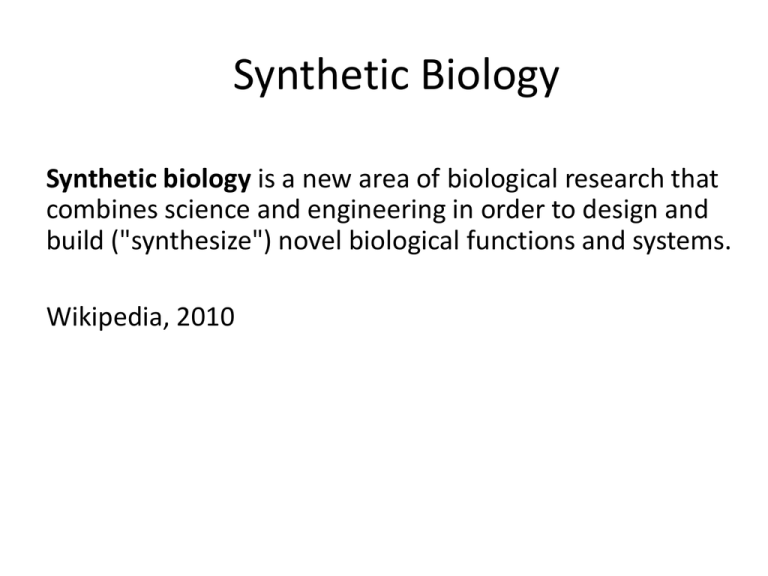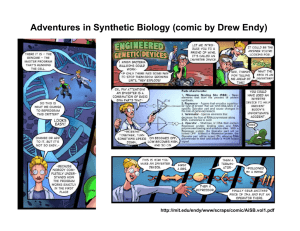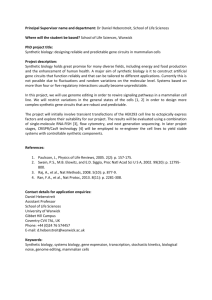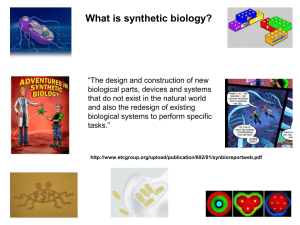Synthetic Biology
advertisement

Synthetic Biology Synthetic biology is a new area of biological research that combines science and engineering in order to design and build ("synthesize") novel biological functions and systems. Wikipedia, 2010 Synthetic Biology Potential Application Areas Or: looking ahead to the next 50 years • Understanding Biological and Complex Systems Synthetic Biology Potential Application Areas Or: looking ahead to the next 50 years • Health: • Diagnostics • Microbial Sensors • Health Monitors • Disease Management • Inherited Diseases } Smart Drugs Synthetic Biology • Chemical Engineering • Natural Product Synthesis • Novel Chemical Feeds Stuffs • New Computational Technologies • Liquid Based Computers • Parallel Processing • Self repairing systems • Analog computers at the molecular level Synthetic Biology • New Materials • Living/Non-Living Interfacing Materials • Neural Implants • New Enhanced Tissues (Stronger bone) • Novel Materials, Wood++ (Smart materials) • Programmed Development, complex structures • Nano Assembly (DNA Origami) • New BioMechno-devices Caltech Synthetic Biology • Whole Genome Design and Construction • New Life Forms • Fully Customized Organisms • Environment • Bioremediation (clean up our mess) • Advanced GMOs (maybe?) • Energy: Solar based Biofuel Production • “Steak in a vat” • Terraforming Existing Applications 1. Genetic Logic Circuits 2. Binary Logic Decoder 3. Natural Drug Production 4. Pipe Repair 5. Breast Cancer Targeting Phage 6. Alarm clocks 7. Bacterial Powered Battery 8. Arsenic Detector 9. Cadmium Detector 10. Nitrate Detector 11. Bioplastic Production 12. Landmine Detection 13. Heavy Meta Scavengers 14. Interspecies Optical Communication Existing Applications 1. 2. 3. 4. 5. 6. 7. 8. 9. Pattern Formation Pesticide Degrader Detect Multiple Heavy Metals E. coli Fragrance Factory Fast Acting Wound Dressing Multi-Wavelength Color Detector Random Number Generator All-in-one Protein Expression and Purification System Etc etc Key Technologies • • • • • • • Basic Genetic Engineering Protein Engineering Fabrication Modeling Measurement Standards Abstraction Genetic Engineering • • • • Cut and ligate (Join) DNA (Restriction enzymes) Transform Cells Polymerase Chain Reaction (PCR) Automated Sequencing Fabrication • DNA Synthesis • Standard Assembly Methods – Tom Knight’s BioBrick Assembly – Freiburg Fusion – In-Fusion Biobrick Assembly http://openwetware.org/wiki/In-fusion_biobrick_assembly http://bbf.openwetware.org/Standards/Technical/Formats.html Standard BioBrick Assembly B0034 = RBS Brick C0010 = Terminator Standard BioBrick Assembly University of Virginia iGEM Team Modeling TinkerCell.com : Deepak Chandran Bioeng, UW Modeling TinkerCell.com : Deepak Chandran Bioeng, UW Modeling TinkerCell.com : Deepak Chandran Bioeng, UW Why do Modeling? What is a model: A simplified piece of reality, a work of fiction. Purpose: 1. 2. 3. 4. To obtain answers about what will happen in the physical world To influence further experimentation To foster conceptual progress and understanding To assist in the axiomization of a physical situation Why do Modeling? Models should be able to satisfy the following two requirements: 1. Be able to describe current knowledge 2. Be able to make non-trivial predictions A good model should be: 1. Salient – should not represent everything! 2. Parsimonious - be as simple as possible 3. Predictive 4. Falsifiable 5. Understandable and explanatory Type of Models 1. Discrete or Continuous 2. Deterministic or Stochastic 3. Linear of Nonlinear Common models in synthetic biology include all of them! Measurement GFP: Green Fluorescent Protein And lots of other colors Measurement Simpson, Nature 439, 608 (2006) DNA Abstraction in biology Metabolic reactions Systems OO O O O Lac Repressor Tet Repressor Devices Plac Op Parts tetR








